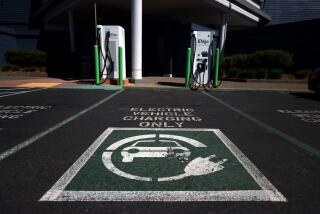Adding Distance to Your Drives : Higher federal mileage standards for new cars can help beat oil dependence
Japan is the most energy-efficient industrial nation, and it keeps getting more so. Japan produces a dollar’s worth of goods and services with half the energy this country uses.
How did they do it?
First, by tightening up on energy consumption the same way Americans did after the first oil embargo in 1973. The difference, as Ronald Morse, an energy specialist at the Economic Strategy Institute in Washington, told the Wall Street Journal recently, is that Japan “continued what we abandoned.” Some of what we abandoned were conservation measures imposed by laws that were dismantled or relaxed by the Reagan White House.
In one example, the White House intervened to allow fuel economy standards for automobiles slip in 1985. Instead of the 27.5 miles per gallon that Congress wanted, Detroit was allowed to build a fleet that averaged only 26 m.p.g.
Then, even with the slippage, the Corporate Average Fuel Economy law that Congress passed in 1975 helped cut consumption of petroleum by 2.5 million barrels a day.
Now a bill by Sen. Richard H. Bryan (D-Nev.) would raise fuel- economy standards to a new plateau. Fuel efficiency for all cars sold in the United States would rise on a gradual basis to an average of 40 m.p.g. by 2001 from the current 27.5 m.p.g.
Understandably, the auto industry is resisting, because meeting the new standards will cost money. But it is using arguments that might have been more persuasive before the first global fuel shock of the 1990s, the Persian Gulf crisis that will keep oil prices at or near $30 a barrel for the rest of the year and perhaps longer.
One argument is that family-size cars are almost twice as efficient as they were when the CAFE standards were first imposed. True enough, but we have to do more. It is estimated that an extra investment of $500 at the time of purchase would result in fuel savings of $2,000 over the car’s life.
Another argument is that the higher standards cannot be achieved with any technology on the horizon except by shrinking automobiles to tiny, sluggish contraptions that buyers would snub in droves. That’s probably not true. An authoritative study published by Washington’s American Council for an Energy Efficient Economy points out that technologies already on the shelf could achieve an average 43.8 m.p.g. without changing either size or performance.
Congress can send its own personal message to the Persian Gulf this week by voting for better mileage.






